NNadir
NNadir's JournalUkraine and Westinghouse sign agreement to Build A Nuclear Plant.
Ukraine and Westinghouse sign agreement for Khmelnitsky AP1000Subtitle:
Excerpts of the article:
Kotin said: "We have reached a very important stage in the process, which was started back in 2021 during the visit of the President of Ukraine, Volodymyr Zelensky, to the USA. I believe that the signing of the contract for the purchase of equipment for the AP1000 power unit is an epoch-making event in the development of the domestic nuclear power industry. The first western power unit in Ukraine will add more than 1100 MW of capacity and strengthen domestic energy independence."
Haluschchenko said the agreement was part of the country moving away from Russian technology in its nuclear energy industry, noting of the AP1000 "such reactors did not exist in Ukraine, they do not exist in the post-Soviet space, and they do not yet exist in Europe ... this is important for strengthening the energy security of Ukraine and renewing our nuclear power industry, which was, is and will be the key generation in Ukraine".
Fragman said: "We are moving to a new level of cooperation. This agreement is of fundamental importance for the energy security of Ukraine, because it is a very reliable technology. Today, five AP1000 units are in operation in the world, in particular in the USA and China, five more are almost ready for start-up. Poland and Bulgaria are interested in the construction of such reactors, as well as a number of other countries."
The go-ahead for the pilot AP1000 project in the country at Khelmnitsky was signed in November 2021, with another one proposed for the same site among the nine new AP1000s planned in total in Ukraine...
Ukraine is planning for a time past the war, and it's nice to see this effort to eliminate dependence on fossil fuels, the chief export of Russia. It is moreover, a serious effort to limit, for the benefit of humanity beyond Ukraine's borders, to address climate change.
Somehow I got on Tammy Murphy's mailing list.
I'm getting a lot of texts and emails.
I'm an Andy Kim kind of guy though.
I'm miserable tonight.
Not only am I suffering from the worst kind of recalcitrant insomnia, but for reasons I can't explain, I have a Billy Joel song - the worst one, Piano Man - going through my head.
I can't stand Billy Joel.
Canadian Hydroelectric Power Generation Fell to the Lowest Level in a Decade Sept 2023 Because of Climate.
I'm on the mailing list of the IEA.
A link in my news feed is to Monthly Electricity Figures for the OECD.
Here one can see how the solar industry performs all winter. One can also see how the wind industry performs in summer, when, because so called "renewable energy" failed miserably to address climate change, extreme temperatures are observed people risk dying without air conditioning.
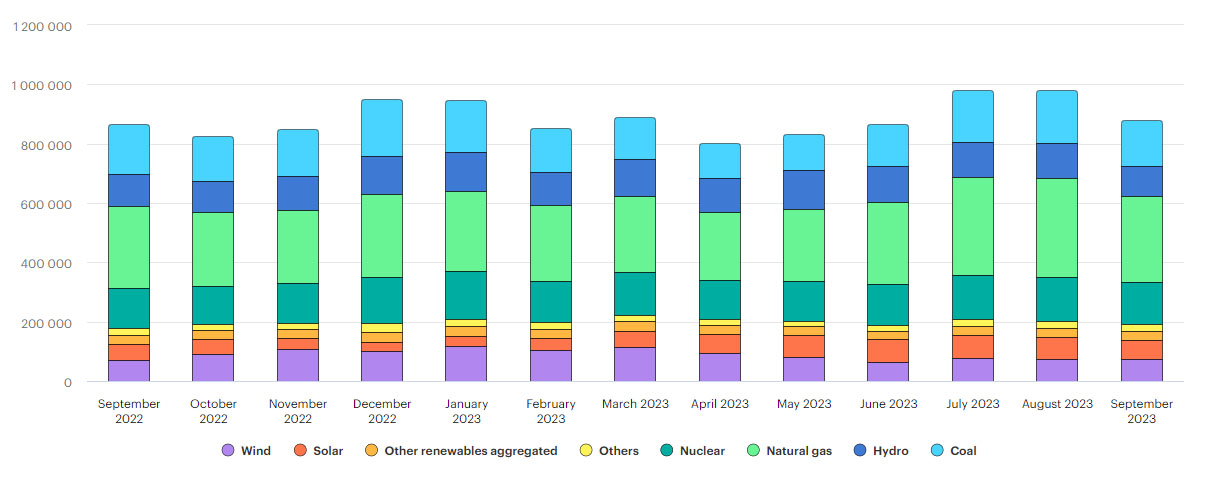
At the link the graphic is interactive; numbers are provided by moving the cursor.
There's an interesting note on the state of hydroelectricity in Canada:
I added the bold.
New York shut the often maligned but reliable Indian Point Nuclear Power Point because they can rely on Canadian hydroelectricity.
It may not have been the most outstanding idea to make our energy supplies dependent on the weather when we have actively destabilized it.
Scientists in Antinuclear Hellholes Develop a Means to Measure Tritiated Water Vapor in Nuclear Plants
The paper I'll discuss in this post is this one: Development of a Novel Passive Monitoring Technique to Showcase the 3D Distribution of Tritiated Water (HTO) Vapor in Indoor Air of a Nuclear Facility Bin Feng, Martin Ibesich, Dieter Hainz, Daniel Waidhofer, Monika Veit-Öller, Clemens Trunner, Thomas Stummer, Michaela Foster, Markus Nemetz, Jan M. Welch, Mario Villa, Johannes H. Sterba, Andreas Musilek, Franz Renz, and Georg Steinhauser Environmental Science & Technology 2023 57 (48), 20024-20033.
The paper is free to read at the link.
The authors of this paper all reside in the officially antinuke countries of Austria and Germany, neither of which have any operating commercial nuclear plants, and both of which are dependent on fossil fuels, with vague and dishonest claims that they will someday, somehow at sometime energy be 100% so called "renewable energy." Twelve of the authors are from a facility that operates a very small TRIGA research reactor, a reactor type about which I'll briefly comment below, the only nuclear reactor in Austria, and two are from Germany.
Austria, a small country with a population of less than 10 million people is mountainous, and can generally rely on hydroelectricity, at least until the failure to address climate change destroys all of the Alpine glaciers, which it is doing. As an indication of the state of electricity in Austria, they announced a plan to reopen a coal plant that they shut when Putin stopped selling them dangerous natural gas: 'Unimaginable': Austria prepares to reopen coal power station.
The adjective applied by the journalist is hardly accurate. It takes no imagination to recognize reality: If anyone studies the carbon intensity of Europe regularly, as I do, one can see that the victory of the fear and ignorance perpetrated by antinukes - to my mind the intellectual equivalents of antivaxxers - leads to the embrace of dangerous fossil fuels.
As of this writing, a Sunday, at the Electricity Map, accessed at 12/17/2023 at 11:28 EST (US), the carbon intensity of Germany is 362 grams CO2/kWh, that of Austria 208 grams CO2/kWh, compared to France's 34 grams CO2/kWh. In the "percent talk" used by advocates of so called "renewable energy" to obscure its uselessness in addressing climate change, Germany's carbon intensity is 1065% higher than that of France, and Austria's 611% higher than that of France.
There were a lot of protests in Austria with respect to the Temelin reactors in the neighboring Czech Republic, which led to some Czech humorists, ten or so years ago, to found a website called Start Zentendorf. (The original website can be found by googling, the link to which I found it does not translate to DU.)
The Zwentendorf nuclear reactor in Austria was completed but never operated as the result of a narrowly approved plebiscite in 1978, in which the Austrians voted, with less than 51% of the vote, not to operate the plant. The humorists of course made the correct point that this was basically a decision to kill people with the use of fossil fuels, although the remarks about the fact that coal burning releases uranium aerosols to the air - which is a true statement - is somewhat disingenuous with respect to the claim that "Closed Zwentendorf" is making Europe radioactive.
Over in the Ennui and Excuses forum, one can locate a post by a fossil fuel salesperson, working to greenwash fossil fuels as "hydrogen," carrying on insipidly about the releases of tritiated water at the Fukushima plant, which has been going on for several months now, this without producing a single death or other environmental consequence. The coal and gas burned to power computers around the world to carry on about this nonevent - a nonevent in practical concerns - has killed more people than the tritiated water in the Pacific ocean ever will.
Graphic Account of the Fukushima Tritium Releases Now Underway: Science.
Fossil fuel advocates and promoters have a long history of opposing nuclear energy, and often use disingenuous rhetoric to obscure what they are doing.
The paper under discussion hints, albeit with some obscuration, on the real consequences of worrying about tritium, which is to generate fear and ignorance that kills people, since nuclear energy saves lives.
Prevented Mortality and Greenhouse Gas Emissions from Historical and Projected Nuclear Power (Pushker A. Kharecha* and James E. Hansen Environ. Sci. Technol., 2013, 47 (9), pp 4889–4895)
That is at least how I, somewhat generously, interpret the bolded remarks - my bold - in the introduction to the paper.
...hence cause socioeconomic damage...
Opposing nuclear energy, when successful, kills people. Period. No debate. As I often remark, nuclear energy does not need to be risk free to be superior to everything else, it only needs to be superior to everything else, which it is.
Tritium is a low energy radionuclide, a pure beta emitter, and is widely used in research settings. As a pure beta emitter, radiation from it is not very penetrating and the health consequences, if they exist at all, are trivial, particular with respect to the huge death toll associated with fossil fuel waste, aka, "air pollution" and "climate change." Environmental concentrations of this nuclide peaked in 1963, around the time that the open air testing of thermonuclear weapons ceased. It has been falling since 1963. I note that 1963 was well before major commercial nuclear power plants became relatively common.
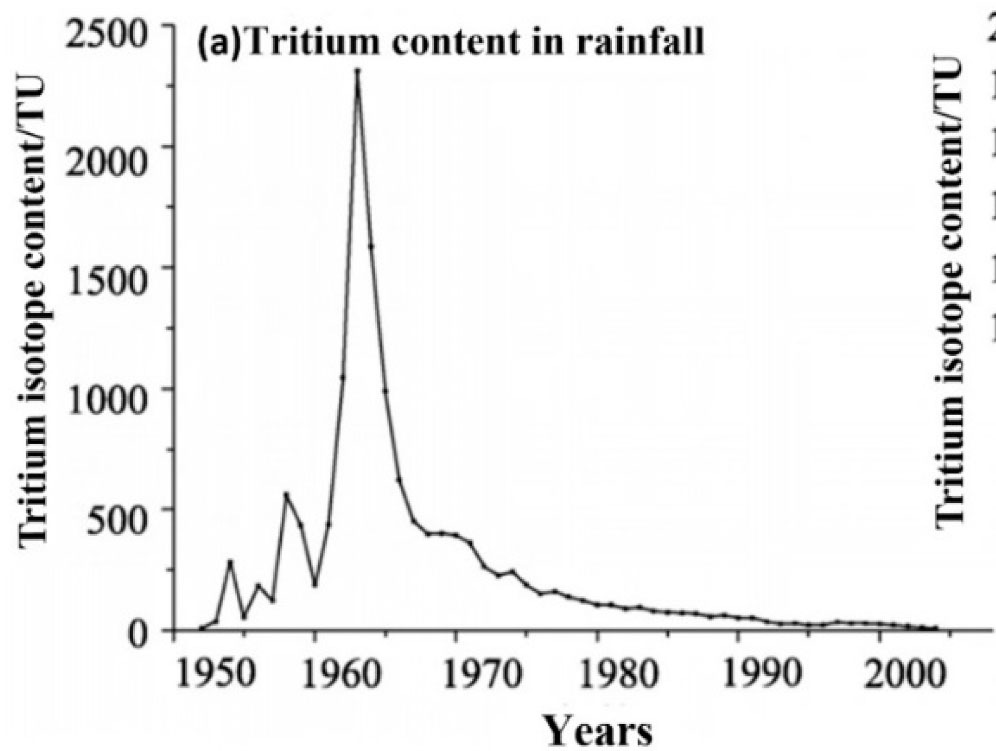
Tian, X.; Gong, Z.; Fu, L.; You, D.; Li, F.; Wang, Y.; Chen, Z.; Zhou, Y. Determination of Groundwater Recharge Mechanism Based on Environmental Isotopes in Chahannur Basin. Water 2023, 15, 180.
The note in the full text of the paper under discussion says tritium concentrations will rise, which is not clear to me as the nuclide is sensitive to Bateman equation type secular equilibrium. In any case, this is trivial. In the absence of a thermonuclear war or the development of fusion energy - which remains unlikely in any time frame that will matter - tritium concentrations remain trivial.
The authors work in a nuclear facility, the Triga research reactor zone. The Triga reactor was developed in the 1960's, inspired by the suggestion of Edwin Teller, and designed by Freeman Dyson.
When I asked Dyson about this bit of history when I met him, he denied that his work was all that essential: To him the design was fairly obvious. He modestly attributed the major development work to Massoud T. Simnad, a materials scientist to whom Dyson referred as a "chemist." This made me proud to be a chemist.
The authors of the paper, which again, can be read in full for free, measure tritium concentrations around their very old small reactor. If Austria ever becomes a sensible nation and responds favorably to the "demands" of the Czech humorists, and opens Zwentendorf - in other words if the Austrian public ever becomes concerned with the fate of humanity and the health of neighboring Europeans - they will almost certainly find lower - and even more trivial - concentrations of tritiated water in a large scale nuclear reactor that will be operating to save human lives.
Have a nice Sunday afternoon.
The CO2 Concentrations at Mauna Loa are 25.91 ppm higher than 10 years ago.
As I've indicated repeatedly in my DU writings, somewhat obsessively I keep a spreadsheet of the weekly data at the Mauna Loa Carbon Dioxide Observatory, which I use to do calculations to record the dying of our atmosphere, a triumph of fear, dogma and ignorance that did not have to be, but nonetheless is, a fact.
Facts matter.
When writing these depressing repeating posts about new records being set, reminiscent, over the years, to the ticking of a clock at a deathwatch, I often repeat some of the language from a previous post on this awful series, as I have been doing here with some modifications. It saves time.
A recent example of posts here relating to this disturbing habit of mine is this one: New Weekly CO2 Concentration Record (Provisional) Set at the Mauna Loa Observatory, 424.63 ppm.
This week's is unsettling, but then again, most weeks give unsettling data; the concentrations continue to rise at a rate that is accelerating, all the reactionary bullshit about the so called "renewable energy," batteries and hydrogen notwithstanding.
The planet is burning.
This week's readings:
Weekly value from 1 year ago: 418.81 ppm
Weekly value from 10 years ago: 396.39 ppm
Last updated: December 17, 2023
Weekly average CO2 at Mauna Loa
As noted in previous posts, the fact that this week's reading is lower than the record from last spring is a function of sinusoidal seasonal variations:

Monthly Average Mauna Loa CO2
This week's reading 422.20 ppm compared to last year's 418.81 ppm is "only" 3.39 ppm higher, which in the 20th century would have seemed outrageous but is now, regrettably, not all that dramatic.
As of this reading, there are 2,497 weekly readings that can be accessed at the Mauna Loa website; 3.39 ppm is "only" the 104th highest, in the 95th percentile.
Of the top 50 weekly readings, 40 occurred in this century, with 6 others taking place in 1998, when fires set in Southeast Asia to clear rain forest for palm oil plantations to supply "renewable biodiesel" to Germany went out of control because of drought, making 1998 the worst year for accumulation of CO2, at least until 2016.
This should have said something about the reactionary impulse to return to the 19th century and make energy supplies dependent o the weather, precisely at the time we have drastically destabilized the weather by not doing anything meaningful about climate change, but it didn't do so.
What is notable about this week's reading is that it is 25.81 higher than the reading of the same week 10 years ago.
Of the top 50 comparator's of weekly readings compared week-to-week with those of the same week 10 years ago, this is the 7th highest.
All of the top 50 such comparators have occurred since 2019, six of them in that year, the rest since and including 2020.
A 52 week running average of all comparators of concentrations of the dangerous fossil fuel waste CO2 in the planetary atmosphere in the past year is currently 24.35 ppm/10 years = 2.44 ppm/year. In the week 49 of the year 2000, the week beginning December 3, 2000, that running average was 15.19 ppm/10 years - 1.52 ppm/year.
We spent over 3 trillion dollars in the period between 2004 and 2019 rendering wilderness and farmland into industrial parks for wind and solar energy. Many here and elsewhere may think that this was "doing something." All this proves that people can lie to each other and lie to themselves, but that numbers don't lie. The effort to address climate change with wind and solar energy is obviously a grotesque failure, in particular because the reactionary impulse to employ so called "renewable energy" was originally never about climate change, but was rather about attacking the last best hope of humanity, nuclear energy. The obviously delusional belief that solar and wind energy have something to do with addressing climate change was and is an afterthought.
Source:
I manually entered the figures in the bar graph in figure 8 to see how much money we've thrown at this destructive affectation since 2004 (up to 2019): It works out to 3.2633 trillion dollars, more than President Biden has wisely recommended for the improvement of all infrastructure in the entire United States.
Have a nice day.
Assessing the Supply Chain Risks of Electric Vehicles and Their Sustainability.
The paper to which I'll refer in this post is this one: Assessing Short-Term Supply Disruption Impacts within Life Cycle Sustainability Assessment─A Case Study of Electric Vehicles Marcus Berr, Roland Hischier, and Patrick Wäger Environmental Science & Technology 2023 57 (48), 19678-19689
This paper is available to the public to read for free, a gift to society (for those interested in sustainability) from the American Chemical Society.
There is a myth that electric cars, and electric things in general, are all "green." It's a myth because electricity, like most of the world's energy supply, is largely provided by dangerous fossil fuels, despite all the marketing and pretense that claims that so called "renewable energy" is a significant provider of energy.
It isn't. So called "renewable energy" is a reactionary land intensive and material intensive expensive and disastrous failure.
The article here is about material intensity of a popular, but I think disingenuous, putatively "green" device, the electric car.
Now, I have been driving a hybrid car which was recently completely demolished - it was less than a year old - in an accident when a young woman ran a stop sign. I waited six months to get the car in the first place, and I am now in my second month of waiting for its replacement to come off back order - I expect to receive the car before the end of the year.
Since the supply chain for a hybrid car is similar to that of an electric car, I have direct experience of what I speak.
Note too, that as a critic of the car CULTure in general, and as a critic of the moral costs of batteries, I can easily and irrefutably be characterized as a hypocrite, to which I can only offer a week defense, that a hybrid car is slight less obnoxious than an electric car, since a hybrid car recovers otherwise waste exergy, specifically that of braking, going down hill - the car will not exceed the speed to which it is set on cruise control - and, to the extent it runs when stopped, idling. Thus the thermodynamics of the system, involving fewer energy transformations subject to the 2nd law of thermodynamics, is less odious from my perspective.
An electric car, by contrast, consumes exergy charging off a grid, as electricity on the grid is a thermodynamically degraded form of energy already, and by storage and discharge, involves far more losses to entropy.
Again, the paper is open sourced, but a few excerpts and telling graphics are in order:
Mechanisms leading to resilience in supply chains have been identified by Sprecher et al. (12,13) using a case study from the 2010 rare earth crisis. These mechanisms include, for example, increases in supply diversity, improvements in material properties, and substitution. In another study, Sprecher and colleagues (14) identify stockpiling as a suitable response option to supply disruptions caused by unexpected events for metals produced as coproducts.
To identify measures suitable for mitigating supply risks, potentially disrupted flows along supply chains first need to be anticipated. Here, criticality assessment is useful, as it allows for assessing the relative importance of supply disruptions for materials/products. Several critical studies have already been performed with regard to the electromobility sector. For example, Helbig et al. (15) have used the criticality assessment approach developed by Tuma et al. (16) to assess the supply disruption impacts for raw materials used for different traction batteries...
While the reference to the "Democratic Republic" of Congo refers only to political instability - it's a bit of sugar coating - the real issue is moral, human slavery.
Every time I sit in my swell hybrid car (when it comes) and push the ignition button, I am participating in human slavery, and to the extent I ignore that I am worse than morally obtuse.
A few graphics:
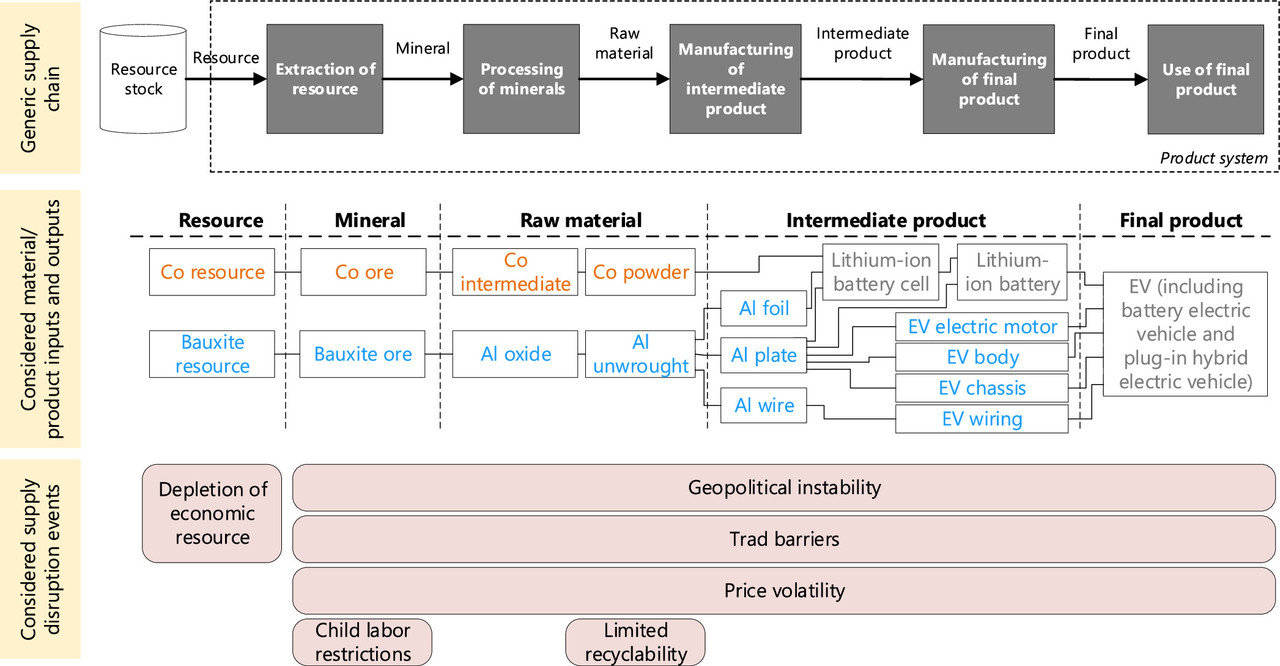
The caption:
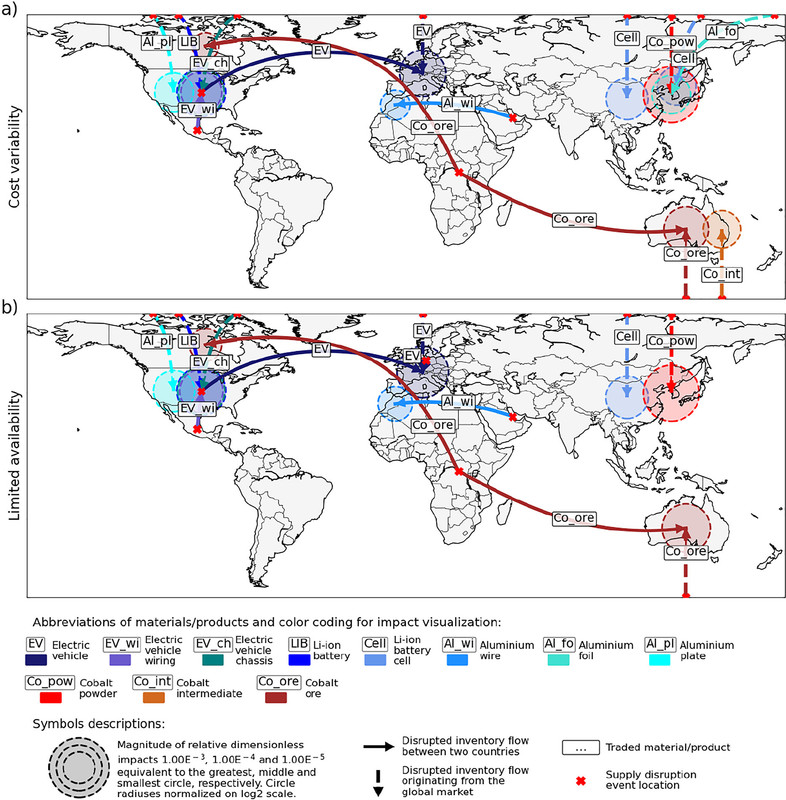
The caption:
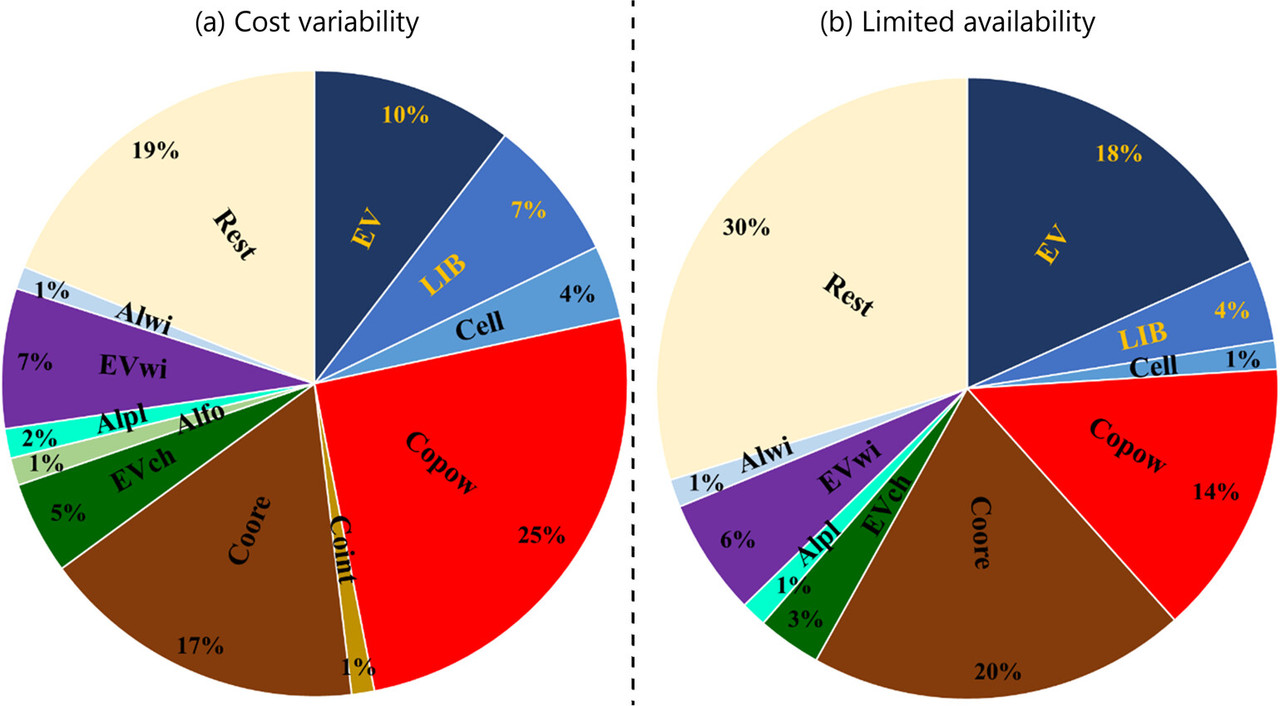
The caption:
I don't expect we'll stop kidding ourselves; experience teaches we will do everything in our power to avoid doing so, but there will be hell to pay, there is hell to pay.
Have an enjoyable weekend.
On the 70th Anniversary: The Legacy of Eisenhower's Atoms for Peace Speech.
Viewpoint: The legacy of Eisenhower's Atoms for Peace speechSubtitle:
Her full speech can be read at the link.
Some excerpts:
Seventy years ago, in 1953, President Dwight D Eisenhower delivered his historic Atoms for Peace speech.
On that day, he set out a vision to harness the power of the atom for the betterment of humanity, setting the stage for international cooperation in the pursuit of peace and prosperity - a vision that has grown into a lasting legacy.
As we know, "it only takes one seed to grow a forest", and now, as we reflect on the past 70 years, we see that Eisenhower's vision has indeed germinated into a forest of possibilities for the peaceful uses of nuclear applications...
...Looking forward, we must paint an ambitious outlook for the nuclear sector, one that honours Eisenhower's vision and prepares us for the challenges and opportunities of the 21st century. The legacy of Atoms for Peace must inspire us to increase the contribution of nuclear for a better and brighter world. We must dream big and work tirelessly to transform those dreams into reality.
So, what are the key actions for us today that will lead us into this brighter future?
First, safety and security will remain paramount. Our commitment to non-proliferation and safeguards is unwavering and was a pillar of the Atoms for Peace vision. We must continuously invest in research and development to enhance the safeguarding of nuclear materials.
Second, we must prioritise sustainability. We know well the contribution of nuclear to mitigating climate change. Our actions must reflect a profound commitment to reducing impacts on the environment, by extending the life of existing nuclear power plants we can maximise 24/7 clean energy contributions. The continued presence and integration of nuclear energy into a broader energy mix, alongside renewables, can help us achieve a more resilient, low-carbon future...
In a dark country, a ray of light.
I cannot tell anyone in a brief series of remarks, what an important development this is, surprisingly, in the dismantling of nuclear arsenals for war, and the addressing of the most important crisis before us, climate change.
MOX fuel with minor actinides produced for BN-800 reactor
Subtitle:
Minor actinides are transuranic elements other than plutonium which are formed in irradiated nuclear fuel. They are highly radioactive and have long half-lives.
Rosatom said that the proposed Russian solution to what are the most hazardous components of nuclear waste is via fast neutron reactors which can be fuelled not only by enriched natural uranium, but also by secondary products of the nuclear fuel cycle, such as depleted uranium and plutonium. "In addition, the research shows that minor actinides from spent nuclear fuel under the flux of fast neutrons will fission into fragments representing a fairly wide range of radioactive and stable isotopes, but in general their potential hazard will be much lower than that of the original minor actinides," the company said.
Alexander Ugryumov, senior vice president for research and development at Rosatom's fuel division, TVEL, said: "Rosatom is step-by-step taking the unique advantages that powerful fast neutron reactors provide to our industry. The introduction of MOX fuel enables the expansion of the resource base for nuclear power multifold involving depleted uranium and plutonium, and also to reprocess irradiated fuel instead of storing it. Afterburning of minor actinides is the next step in closing nuclear fuel cycle, which should not only reduce the amount of nuclear waste for final isolation, but also significantly reduce its radioactivity. In the long term, it could avoid the complicated and expensive deep burial of waste..."
Some years back, on another website, I discussed, in general terms, why this type of fuel is essential to minimize the risks of nuclear war, which, by the way, have never been zero, since uranium exists.
On Plutonium, Nuclear War, and Nuclear Peace
Of course Russia is a pariah state, but in a dark place - any dark place - there are always people who work for good. This is a critical development, (pun unintentional but recognized) and one I have hoped for for a long time.
The Execution of Two Abortion Providers in Fascist France (1943).
Since late in life I am forced to wonder how I would behave under fascist rule, having never had to call on real courage, I am reading (in excerpts) an interesting history book, France, the Dark Years 1940-1944, by Julian Jackson.
It's an interesting read, in particular with respect to the behavior of French intellectuals under Vichy and Nazi occupation, but this passage struck me as our modern fascists try to put their bloody hands on women's bodies. I am reading the hardcover edition published by Oxford University Press, copyright 2001. From page 332:
...In the circumstances of the Occupation - the presence of strangers in local communities (whether Germans or refugees), the absence of husbands, and the burden represented by unwanted babies in a period of shortages - it is hardly surprising that the number of abortions increased. The real figures can only be guessed, but the evidence of post-abortion cases arriving in hospitals suggests a sharp rise in 1941-2, possibly between 400,000 and one million per annum. They were usually married women of modest means, often with a small family. Mostly the abortions were carried out by family friends not professional abortionists.
It can happen here; it is happening here.
Profile Information
Gender: MaleCurrent location: New Jersey
Member since: 2002
Number of posts: 33,518